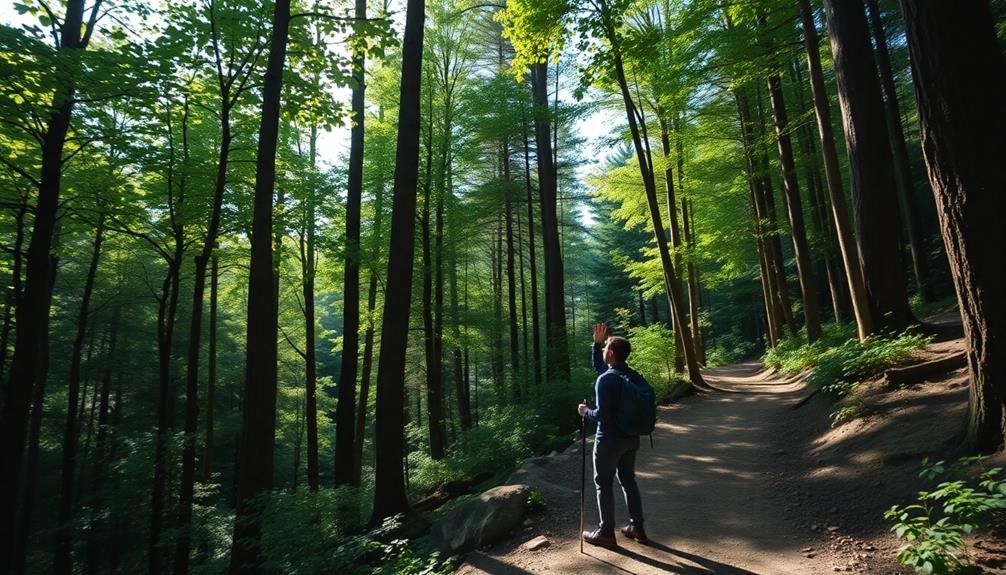Solo hiking can be a thrilling experience, especially when you have the right strategies to alleviate your nerves. Start by choosing familiar trails and planning your route carefully. Begin with short hikes to build confidence and consider practicing mindfulness techniques to stay grounded. Always pack essential safety gear and inform someone about your plans. Trust your instincts while on the trail, and don't hesitate to reflect on your experiences afterward. These strategies will help you enjoy your adventure while feeling secure. There's so much more to explore to guarantee a positive hiking experience that's waiting for you.
Choose Familiar Trails

When you're planning a solo hike, it's best to choose familiar trails. Opting for paths you've explored before lets you focus on enjoying the outdoors without the stress of traversing the unknown. You know the terrain, the landmarks, and the potential challenges that might arise. This familiarity builds your confidence and allows you to respond quickly if something unexpected happens.
By sticking to trails you've hiked in the past, you can better gauge your pacing and energy levels. You're aware of how long it takes to reach certain points, which helps you plan your time effectively. Plus, you'll have a clearer idea of where the nearest exit points are if you need to cut your hike short.
Familiar trails also allow you to appreciate the details you might've overlooked during previous hikes, like unique rock formations or hidden viewpoints. This deeper connection to the landscape can enhance your experience and make your solo hike more enjoyable.
Plan Your Route Carefully
When you plan your solo hike, it's essential to research trail conditions to avoid surprises.
Make sure to use navigation tools, so you stay on track and don't get lost.
Don't forget to share your itinerary with someone; it's a smart safety measure that can make a big difference.
Research Trail Conditions
Before setting off on your solo hike, it's essential to thoroughly research trail conditions to guarantee a safe and enjoyable experience. Knowing what to expect can help you avoid potential hazards and make sure you're prepared for the journey ahead.
Here are a few key areas to focus on:
- Weather Updates: Check the forecast for the day of your hike and the days leading up to it. Sudden changes in weather can impact trail conditions considerably.
- Trail Reports: Look for recent trail reports or updates from local hiking groups or park services. This information can provide insights into trail closures, washouts, or other obstacles.
- Wildlife Alerts: Be aware of any wildlife activity in the area, such as bear sightings or snake activity. Understanding what animals you might encounter can help you stay alert and prepared.
Use Navigation Tools
Planning your route carefully is essential for a successful solo hike, and using navigation tools can make all the difference. Start by picking a reliable map or a hiking app that suits your needs. Familiarize yourself with the trail, noting key landmarks, elevation changes, and potential hazards. This knowledge will boost your confidence and help you stay oriented.
Next, consider a GPS device or a smartphone app with offline maps. These tools can provide real-time location tracking, ensuring you don't stray off course. Make sure to download maps ahead of time, as cell service may be spotty or nonexistent in remote areas.
Always carry a compass and know how to use it, even if you rely on technology. In case of a malfunction, you'll have a backup plan.
When planning your route, account for your fitness level and the estimated time it'll take to complete the hike.
Don't forget to factor in breaks and the time needed to return. By preparing with these navigation tools, you'll feel more secure and ready to face the great outdoors.
Share Your Itinerary
Sharing your itinerary is a key step in ensuring your safety while solo hiking. When you let someone know your plans, you create a safety net that can be vital in case anything goes wrong.
Here are a few essential points to include when you share your itinerary:
- Start and end points: Clearly outline where you'll begin and finish your hike.
- Estimated time: Share how long you expect to be out on the trail, factoring in breaks and any potential delays.
- Emergency contacts: Provide a list of people who can be reached in case of an emergency.
Make sure to update your itinerary if plans change, and always stick to the route you outlined.
This way, if something unexpected happens, rescuers will know where to look for you.
Also, consider sharing your plans on a hiking app or with local authorities if the area requires it.
Start With Short Hikes

Starting with short hikes is a smart way to build your confidence and skills as a solo hiker. By choosing trails that are familiar or well-marked, you can focus on getting comfortable in the outdoors without overwhelming yourself. Start with hikes that last one to three hours, allowing you to enjoy nature while keeping the experience manageable.
As you initiate these shorter excursions, pay attention to your surroundings and practice navigation skills. Learn how to read maps or use a GPS app, which can boost your confidence for longer hikes later on. It's also helpful to set small goals, like reaching a particular viewpoint or completing a loop trail. Each accomplishment will reinforce your capabilities and encourage you to push further.
Additionally, short hikes allow you to test out your gear and assess what works best for you. Take time to experiment with your backpack, clothing, and shoes.
Use a Buddy System
When you're new to solo hiking, using a buddy system can provide an extra layer of safety and support. Having a hiking partner allows you to share the experience and look out for each other, which can greatly ease your nerves. You don't have to venture out alone right away; this system helps build your confidence.
Here are a few key benefits of hiking with a buddy:
- Shared Responsibility: You can keep each other accountable for safety measures like packing essentials and sticking to planned routes.
- Emotional Support: Steering through unfamiliar trails is less intimidating when you've got someone beside you, ready to encourage you when doubts creep in.
- Enhanced Enjoyment: Sharing the beauty of nature and the thrill of discovery makes the experience more memorable and enjoyable.
As you gain more experience and confidence, you can gradually start tackling solo hikes. Until then, don't hesitate to rely on your buddy system. It's a great way to enjoy the outdoors while ensuring you feel safe and supported.
Practice Mindfulness Techniques

Often, practicing mindfulness techniques can enhance your solo hiking experience. By focusing on the present moment, you can reduce anxiety and truly connect with your surroundings. Start by taking deep, intentional breaths as you walk. Inhale the fresh air, and exhale any tension. This simple act grounds you in the here and now.
As you hike, engage your senses. Listen to the rustle of leaves, feel the texture of rocks under your hands, and notice the vibrant colors of the landscape. This sensory awareness not only distracts you from negative thoughts but also deepens your appreciation for nature.
When you encounter challenges, such as steep trails or unexpected weather, practice self-compassion. Acknowledge your feelings of nervousness but remind yourself that discomfort is part of the adventure.
Rather than fixating on fears, focus on the joy of movement and exploration.
Stay Connected With Technology
Staying connected with technology can greatly enhance your solo hiking experience. With the right tools, you'll feel more secure and informed, allowing you to truly enjoy your adventure. Here are a few ways to leverage technology while hiking:
- Use a GPS device: A reliable GPS can help you navigate unfamiliar trails, keeping you on track and preventing you from getting lost.
- Download offline maps: Before you head out, download maps of the area. This way, you'll have access to important trail information even if you lose cell service.
- Share your location: Use apps that allow you to share your real-time location with friends or family. This adds an extra layer of safety, as someone will always know where you are.
Don't forget to bring a portable charger to keep your devices powered throughout your hike.
While technology can enhance your experience, remember that it shouldn't replace your connection to nature. Use these tools to boost your confidence and guarantee a safer journey, but stay present in your surroundings.
Embrace the thrill of solo hiking while feeling reassured by the support of technology.
Pack Essential Safety Gear

Safety should always be a top priority on any solo hiking adventure. To guarantee you're prepared for anything, packing essential safety gear is vital.
Start with a reliable map and compass, even if you're using a GPS. Technology can fail, but these classic tools won't let you down. Next, include a first aid kit tailored to your specific needs; it should have band-aids, antiseptic wipes, and any personal medications.
Don't forget a whistle. It's lightweight but can be a lifesaver in emergencies, signaling for help without exhausting your voice. A multi-tool or knife is also invaluable for various tasks, from preparing food to making repairs.
Additionally, pack a headlamp or flashlight with extra batteries to navigate dark trails or emergencies. A fire starter or waterproof matches can help you stay warm and signal for help if needed.
Finally, always carry enough water and a water purification system or tablets to guarantee you stay hydrated. By packing these essential safety items, you'll boost your confidence and readiness for any challenge the trail throws at you.
Stay safe, prepared, and enjoy your adventure!
Inform Someone of Your Plans
Before you head out on your solo hiking adventure, it's important to inform someone of your plans. This step is vital for your safety and peace of mind. Letting someone know where you're going and when you expect to return can provide an extra layer of security.
Here's what you should share:
- Destination: Clearly outline the trail or area you plan to hike.
- Duration: Specify how long you expect to be out there, including your return time.
- Emergency Contact: Provide a contact number for someone who can reach you or alert authorities if needed.
By keeping someone in the loop, you create a safety net for yourself. If something goes awry, they'll know when to start looking for you, and they'll have your itinerary to guide them.
Make sure to choose a reliable person who can stay put and act quickly if necessary.
Trust Your Instincts

When you're out on the trail, trusting your instincts can be your best guide.
Listen to your gut feelings about safety, recognize spaces that feel secure, and constantly assess your surroundings.
These skills not only enhance your experience but can also help keep you safe during your solo hike.
Listen to Your Gut
Your instincts can be one of your greatest allies while solo hiking. When you're out in nature, it's essential to pay attention to those gut feelings. They often signal when something doesn't feel right, and ignoring them can lead to hazardous situations.
Trusting your intuition isn't just about avoiding danger; it's also about enhancing your overall experience.
Here are some tips to help you listen to your gut:
- Stay aware of your surroundings: If a trail feels off or a noise seems unusual, stop and assess the situation.
- Trust your discomfort: If you feel uneasy about continuing down a certain path or staying in a particular area, it's okay to turn back or change your route.
- Reflect on your feelings: Take a moment to check in with yourself. Sometimes, a simple pause can clarify whether you should proceed or take a different direction.
Recognize Safe Spaces
Recognizing safe spaces while solo hiking is essential for your peace of mind and overall safety. When you're out on the trails, it's important to identify areas where you can rest, regroup, or seek help if needed. Look for open areas with clear visibility, away from dense brush or steep drops. These spots can provide a buffer against unexpected encounters or dangers.
Trust your instincts when deciding if a space feels safe. If something seems off—like strange noises or a lingering, uneasy feeling—don't hesitate to move on. It's better to be cautious than to second-guess yourself.
Also, pay attention to the people around you. If you're near a group, their presence can offer a sense of security, but if individuals make you uncomfortable, seek distance.
Familiarize yourself with landmarks and potential shelters, like cabins or ranger stations, that you can reach if necessary. Knowing where to go can greatly enhance your confidence while hiking solo.
Always trust your instincts and prioritize your well-being. A safe space isn't just about physical safety; it's also about creating an environment where you feel comfortable and secure.
Assess Situational Awareness
Being aware of your surroundings is essential for a successful solo hiking experience. Trusting your instincts can be a game changer when you're out on the trail. If something feels off, don't hesitate to act.
Here are some key aspects to focus on:
- Listen to Your Gut: If you sense danger or discomfort, trust that feeling. Your intuition is often a reliable guide.
- Observe the Environment: Keep an eye on changing weather patterns, unusual animal behavior, or anything that disrupts the natural rhythm of the area.
- Stay Alert to Other Hikers: Not everyone you meet on the trail is a friend. Pay attention to the demeanor of others and your comfort level around them.
Reflect on Your Experience
After a day spent traversing trails, taking a moment to reflect on your hiking experience can deepen your connection to nature and yourself.
Find a quiet spot, perhaps on a rock or beneath a tree, and allow your mind to settle. Think about the sights, sounds, and smells you encountered. What stood out? Was it the rustle of leaves or the scent of pine?
Consider how you felt during your hike. Did you experience moments of anxiety or fear? Acknowledge these feelings without judgment. They're part of your journey. Reflect on how you navigated these emotions, and what strategies helped you feel grounded.
You might also want to jot down your thoughts in a journal. Writing can clarify your experiences and reinforce your insights.
What challenges did you face, and what did you learn about yourself? Each hike is an opportunity for growth, so embrace the lessons you gain.
Frequently Asked Questions
What Should I Do if I Encounter Wildlife on the Trail?
If you encounter wildlife on the trail, stay calm and keep your distance. Don't approach or feed them. Make noise to alert them of your presence, and slowly back away without turning your back.
How Can I Overcome Feelings of Anxiety Before Starting a Hike?
To overcome anxiety before starting a hike, visualize your route, practice deep breathing, and focus on the beauty around you. Remind yourself that you're capable, and take it one step at a time. Enjoy the journey!
What Are the Best Apps for Solo Hiking Safety?
For solo hiking safety, you should download apps like AllTrails for trail information, Gaia GPS for navigation, and Life360 for sharing your location. These tools help you stay informed and connected while you explore.
How Do I Choose the Right Hiking Gear for Beginners?
To choose the right hiking gear as a beginner, start with comfortable footwear, moisture-wicking clothes, and a reliable backpack. Don't forget essentials like water bottles and a first aid kit to guarantee a safe adventure.
What Should I Consider When Hiking in Different Weather Conditions?
When hiking in different weather conditions, consider layering your clothing, staying hydrated, and being aware of trail conditions. Always check the forecast, pack essentials, and adjust your plans if conditions become too challenging or dangerous.
In Summary
To sum up, solo hiking can be a rewarding adventure, even for the nervous adventurer. By choosing familiar trails, planning your route, and starting with short hikes, you can build confidence along the way. Remember to pack essential safety gear and inform someone of your plans. Trust your instincts, practice mindfulness, and reflect on each experience to grow. Embrace the journey, and soon, you'll find joy in exploring the great outdoors on your own terms. Happy hiking!





Leave a Reply